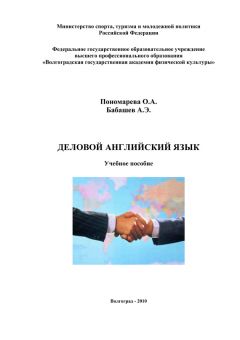Текст книги "Деловой английский язык"

Автор книги: А. Бабашев
Жанр: О бизнесе популярно, Бизнес-Книги
сообщить о неприемлемом содержимом
Текущая страница: 4 (всего у книги 6 страниц) [доступный отрывок для чтения: 2 страниц]
UNIT 6
BUSINESS COMMUNICATION
Management Style
There is a statement: «Management is getting work done through people». A manager's authority in an organization is a matter of rank. Each manager handles authority in a unique way known as management style. One supervisor may be hurried and curt, while another may be patient and friendly. And so it is that some managers are easier to work with than others.
Management style is one part training, nine parts personality. Yet, as an old saying goes, nothing breeds success like success. Higher job status usually increases a person's prestige. In contemporary society, wealth and career success are very important in determining social status. A high-ranking manager expects and receives a great deal of respect from co-workers.
Respect is expressed both verbally and nonverbally. For example, a supervisor respects an employee who is subordinate to follow instructions and take suggestions without resistance or resentment, for a supervisor, regardless of age or sex, has been granted authority. Everyone works in his or her domain. Everyone should adhere to the rules of conduct, i.e. statement of employment duties and responsibilities. Trying to avoid conflicts with anyone in your organization is one of the most important things. So learn how to do that. Lines of Communication
Institutions are organized along lines of communication. In most cases, a manager passes information and instructions to those supervised. Likewise, when employees make a request or complaint, as a rule they report to their own supervisors. It is usually not appropriate to go over the head of a supervisor to speak to a higher-ranking manager. Speaking directly to your own supervisor is usually the quickest way to get Problems solved.
How should you speak to different people in the organization? Sometimes it is difficult, especially in foreign language. So let us begin from the very beginning. What are the main language functions? They are: 1) exchanging information; 2) making requests; 3) persuading others to do what we want; 4) evaluating; 5) expressing feelings opinions, and attitudes. How can we use those functions in our everyday communication at work? Let us consider some cases.
You should think of register use.
Signal when you don't understand: «I beg your pardon? »
Ask that critical information be repeated: «I think I remember how to get started, but I am not sure what to do when I've made a mistake and what to do when I'm finished».
Ask for clarification: «I'm sorry, I'm not sure what you want me to do».
Double-check and ask for feedback. For example, you have to make 19 copies of the document: «That's nineteen, one-nine, right? »
Don't worry about saving face. Your boss knows that it is much cheaper and less timeconsuming repeat directions and prevent errors than to fix mistakes after they have occurred.
Be honest and don't try to cover up mistakes.
Let us consider several examples how to talk to different people,
a. I’m sorry; I didn't mean to do that. I promise you it won't happen again.
Relationship: talking to a manager or other superior
b. You must feel terrible. I wish there were something I could do.
Relationship: talking to a friend or a subordinate
с. I'm sorry, but you will just have to learn to work a little faster.
Relationship: manager to subordinate
d. Why don’t I stay after work for a few minutes and show you how to fill out those forms?
Relationship: friend, peer, boss to subordinate
e. I don't quite see things the same way.
Relationship: peer, subordinate to boss, superior to subordinate
VOCABULARY


Exercise 1. Приведите в соответствие термины и их определения: a) management
b) authority
d) prestige
e) domain
f) register use
1. high quality of your work or your position in society admired by other people
2. changing your language according to the relative status of the speakers involved
3. the power or responsibility to control and command
4. speaking or replying in a brief and rather a rude way
5. the way you control someone or something
6. particular area of activity or interest
Exercise 2. Напишите перевод выражений, которые относятся к функциям речи. Составьте с ними предложения.
1. asking for and giving information 2. asking for clarification 3. elaborating 4. doublechecking information 5. showing comprehension or lack of comprehension 6. expressing concern or dissatisfaction 7. showing sympathy 8. responding to criticism 9. giving reasons 10. apologizing 11. making excuses 12. interrupting 13. asking for permission 14. offering help 15. making requests 16. making suggestions 17. admitting fault 18. showing enthusiasm 19. explaining a problem
Exercise 3. Приведите в соответствие термины и их определения:

Exercise 4. Найдите синонимы:


Exercise 5. Переведите следующие выражения на русский язык. Составьте с ними предложения:
1. tо make decisions; 2. tо achieve goals; 3. tо govern an organization; 4. to run a company; to divide labor 5. to centralize authority; 6. to adhere to rules.
Exercise 6. Приведите в соответствие термины и их определения.
a) domain
b) personal
c) nonpersonal
d) rules of conduct
e) job description
f) adhere to
g) hierarchy
h) socializing
i) conflicting
1. open, not private
2. statement of employment duties and responsibilities
3. area of influence, activity, or responsibility
4. private
5. follow or conform to
6. regulations and/ or expectations regarding behavior
7. conversing about nonwork-related matters
8. a system of grades or levels within organizations
9. contradictory
UNDERSTANDING EASTERN & WESTERN CULTURE
It's important to realize that one of the more subtle aspects of culture has to do the way one thinks about how the world. The following table presents some of the differences between how the Chinese and the Western individuals think about culture and values.


This different cultural world view causes a great deal of frustration and distrust between the individuals attempting to work together. Three examples are listed below.
• An American businessman went to Taiwan to close a deal with the president of a large paper company. Since they were meeting for the first time, they started out with the normal pleasantries such as "How was your trip?" etc. It turned out the American happened to be from Columbus, Ohio, the home of Ohio State University. When the president of the Taiwanese company mentioned that his son was going to this school, the American business person said, "Yes, it's a very good school, let's talk business."
• A while back, two American dotcoms wanted to establish business relationships with potential tech partners in Singapore. Through the intercession of a couple of savvy Singaporeans, an initial meeting was arranged to determine if there might be some areas of commonalties. The two American companies chose as their representative an American lawyer.
• During the same trip, another dotcom company had sent their business development person to meet with Singaporean counterparts. Meeting followed meeting and at the end of the week things looked very promising. Both sides were very pleased at the progress and the potential. Then, two weeks after coming back to the U.S., the contact person was promoted to a VP position and a new person took over.
Americans quickly establish business relationships, but their relationships are generally shallow and not particularly long lasting. Throughout the Orient, it takes time to develop the relationship, but once it's developed, it tends to last for a very long time. This simple observation means the Americans and some Europeans tend to lose out on business deals.
It is also a fairly common practice for multinational corporations to rotate people through a country every two or three years. Of course, once that expat leaves, they take with them relationships it took months and years to cultivate.
To make matters worse, many companies tap employees who are experts in technical or management matters as their overseas managers.
BUSINESS PRESENTATIONS
Speaking up at the office
Every day, employees of various companies around the world find themselves in careerdefining speaking situations. Presentations like these often involve high stakes and are presented to busy people with the power to influence careers.
Different business presentations can make or break your career. The technical briefing, a straightforward presentation to inform, can cause trouble if you lose your audience. For the proposal, you must advocate an idea, product or course of action…and convince others to agree. You may have to present complicated material to a nontechnical audience.
To help with job jitters, professional panic or talk trauma, here is some information:
Stimulate action
When you present a proposal or a pitch, you are trying to do more than simply inform – you are trying to persuade.
A proposal seeks to stimulate action or acceptance of an idea. Here are some examples: A company’s research and development chief proposes that top management authorize additional funding for a key project. An architect presents designs for a condominium complex. An advertising agency director proposes a new ad campaign to a prospective client. An insurance sales representative pitches the idea of a company-sponsored bowling team to the owner of a bowling alley.
In all of these cases, your speech must include sections designed to inform. It often involves a discussion on dollars spent versus gains made. And the gains may be high-tech in nature, such as an improved insulin pump for diabetics. For such situations, some technical information must be included. Yet, the objective of the presentation is to sell a product, a concept or a set of recommendations. By combining your technical expertise with the ability to present proposals that get positive results, you’ll generate many opportunities for visibility and career advancement.
Follow these four steps to prepare:
• Determine your purpose.
• Analyze your audience and determine its needs.
• State your main message and support it.
• Urge the audience to take definite action.
You must determine the effect you want your presentation to have on the audience. Are you selling a product or service? Recommending a course of action? Striving for agreement or approval? Be specific about what you want your proposal to accomplish.
Analyze your audience, and then create your main message to address their wants and needs. Be sure to translate the features of your product, service, idea or recommendation into audience benefits – and target the benefit to fit that audience. For example, if a company’s need is for a quality product with excellent durability, these are the qualities you would highlight as opposed to emphasizing cost savings.
Organizing your proposal
To organize your ideas into an effective proposal, use an approach developed in the field of journalism – the “inverted pyramid.” In the “inverted pyramid” format, the most important information is given in the first few paragraphs. As you present the pitch, the information becomes less and less crucial. This way, your presentation can be cut short, yet remain effective. This approach has other important benefits.
To make the most of these benefits, begin with your main message, followed by the supporting points and detailed data. If your listeners agree with your main message, the supporting material that follows it will reinforce their agreement. If they disagree, they will be focused on your viewpoint from the beginning, and your logic may win them over to your side. If you are allowed your fully-allotted time, make the most of it by ending with a call to action. Telling the audience what you want them to do may seem too aggressive, but it actually helps the audience to select a course of action.
Use visual aids
Effective visuals can illustrate and clarify your verbal message. On the other hand, poor or poorly presented visual aids can seriously damage your proposal and create a negative impression with the audience.
So, keep your visual aids clearly visible to each person in the audience. They must be simple, with each page or slide illustrating a single point.
Handling questions and answers
A question-and-answer period following your proposal or pitch benefits both you and your audience. It provides you with feedback indicating to what extent your listeners accept and agree with your proposal. It also lets you reinforce your message by addressing areas that concern the audience. And it benefits your listeners by giving them an opportunity to get clarification of ideas and data in your proposal.
Here are some tips for effectively dealing with audience questions:
• Plan for them. Announce at the outset of your speech that you will entertain questions. Plan a smooth transition between the conclusion of your proposal and the question-andanswer portion of the presentation.
• Anticipate questions. Try to anticipate the questions your audience will ask. One way is to rehearse your proposal before colleagues or friends and see what questions they have. This has an added benefit: It can indicate elements you’ve neglected to include in your proposal.
• Clarify the question. Before attempting to answer a question, be sure you understand what the questioner wants. If necessary, rephrase it, asking if your interpretation is correct. If you don’t know the answer, admit it, but tell the questioner you will find out the answer later and contact him or her.
• Don’t be defensive. Give your listeners the impression you welcome their questions and appreciate the opportunity to answer them. Your positive attitude can be the “icing on the cake” for a successful proposal.
• Align your answer with your main message. Rather than blurting out the first response that comes to mind, mentally evaluate how you can answer the question in a way that supports what you’ve said in your proposal.
• Disarm loaded questions. Occasionally a questioner may try to trip you with a loaded question – one based on false premises or irrelevant assumptions. Be polite, but don’t back down from your position. You can disarm the questioner by asking him or her to explain the question and share information.
• Divert irrelevant questions. Don’t waste time on questions that are out of place, even if you know the answers. Politely ask the person how the question bears on the proposal.
• Divide complex questions. If a questioner hits you with a multifaceted question, split it into components before answering it. This helps you, as well as other listeners.
• Summarize. Watch your allotted time. Before it expires, conclude by briefly summarizing your proposal. This way, you can control (and prepare for) the way your presentation ends. This is the final impression you leave on your audience, so make it positive and upbeat.
The table below lists useful expressions that you can use to signpost the various parts of your presentation.



Рабочие ситуации
1. Подготовьте собственную бизнес-презентацию товара или услуги
2. Составьте диалоги по заданным образцам:
MEETINGS: AGENDA SETTING
Most meetings have an agenda – a list of matters to be discussed in the meeting. When you decide what to talk about in the meeting, you 'set the agenda'. The person in charge of the setting the agenda and running the meeting is the 'chairperson'. Imagine that you are the chairperson in a meeting. It is the start of the meeting and you are telling your colleagues about the items on the agenda. Use the following phrases:


Clip 1

Clip 2

MEETINGS: INTERRUPTIONS
In business meetings it is sometimes necessary to interrupt a speaker. This is possible but it should be done politely. Imagine that you are in a meeting, and you want to interrupt to ask a question or make a comment. Use the following phrases:



MEETINGS: AGREEING AND DISAGREEING
Inevitably, people will agree and disagree with one another during meetings. It’s important to make your position in a debate clear, while being polite to people you disagree with. Imagine that you are in a meeting and you disagree with someone over an issue. Use the following phrases:


MEETINGS: ANY OTHER BUSINESS
Business meetings typically end with the chairperson asking if there is ‘any other business’. This is an opportunity for anyone present to raise an issue that isn’t on the agenda. After any other business, the chairperson closes the meeting. Imagine that you are a chairperson ending a meeting with any other business. Use the following phrases:



UNIT 7
BUSINESS TRIP
Business trips are just part of doing business. A company tries to choose only its best people to represent it. Trips can happen in or out of the country. And there are as many reasons to go on a business as there are places to go: to sign contracts, to discuss terms of delivery, payment or shipment, to have tests, to consult, to improve one’s professional skills, to provide support. Representatives of the companies involved usually make preliminary arrangements in order to meet. Whether a long-term or short-term trip, the itinerary must be carefully planned by the head of a department or another executive. After the trip, an employee is ordinarily expected to give a full financial accounting of the trip to his boss. Sightseeing, cultural events and just plain relaxing are a regular part of every business trip. And no businessman would dare forget to buy gifts for relatives, friends and colleagues while on a business trip to an interesting, new location. These trips are important because they contribute to the expansion of a company’s business relationships and help that company succeed in the competitive world market.
Business today is international in character, and business people often have to travel. On a business trip people might meet colleagues and business partners for the first time. Often, colleagues from different countries experience cultural difficulties, that is, they are surprised by strange, to them, social conventions in a new place. Different cultures do things differently! Management styles also differ from country to country. It’s often useful when doing business in a foreign land, to get some advice from a special agency which consults on questions of international business. These days business trips are very important because face to face meetings are more valuable to profitable business than any other type of strategy.
VOCABULARY


BUSINESS AND SOCIAL CONTACTS
Distance is no obstacle today and personal contacts have become the most efficient means of promoting a better understanding in all spheres of human activity. Foreign trade is no exception.
Normally, businessmen keep in touch through correspondence or telephone calls, but there's no denying the fact that major problems can be solved more effectively through a personal meeting. Both parties have equal opportunities to hear out their counterpart's arguments and come to an agreement on the business in hand. Since a business trip is always limited in time, a businessman makes arrangements before to his departure or immediately on arrival. Among other things he can make an appointment by telephone or by cable. In the counterpart's country a businessman can make an appointment in person. It is customary for businessmen to draw up a tentative programme of points they would like to take up during the forthcoming meeting.
The programs of the delegation's stay include a series of business talks and social meetings like a sightseeing tours, entertainment, visits to their counterpart's homes, etc. Visitors may have to attend a business lunch or a reception given in honour of the delegation.
It is essential to be punctual in business. If you cannot keep the appointment you should notify your counterpart in advance and fix a new date.
On a formal occasion (talks, a working lunch, a reception) a businessman is expected to wear a suit and tie. Informal occasions (a sightseeing tour, an outing, a visit to a private home) do not call for formal clothes; one should be dressed casually.
Remember that it is always best to behave naturally. Jokes and humor are appreciated just as much as they are elsewhere.
BUSINESS TRAVEL
Never before in the history of the world have businessmen traveled so much as they do today. It is not surprising because we are living in a world of growing international trade and expanding economic and technical cooperation. Fascinating though it is for tourist, traveling however has become the most tiring of all the occupations for many businessmen and experts. Choosing a comfortable hotel to stay at is, therefore, a matter of some importance. There are plenty of good hotels, motels, and guest houses, in the world, conveniently located for major business centers. Many developing countries, such as India, Egypt, Nigeria, Libya, etc have excellent hotels. Their numerous facilities include both large and small cocktail barber's shops and conference halls equipped with simultaneous, multilingual translation systems. There are parking areas which can accommodate a lot of cars. It might be useful for travelling businessmen and tourists to know that tailor shops, shoe repair shops and laundry, dry cleaning services are available for guests. People in the office help guests to book train or steamer tickets and rent a car. They are also ready to give all necessary information.
Nowadays people who go on business mostly travel by air as it is the fastest way of travelling. Passengers are requested to arrive at the airport 2 hours before departure time on international flights and an hour on domestic flights as there must be enough time to complete the necessary airport formalities. Passengers must register their tickets, weigh in and register the luggage. Most airlines have at least 2 classes of travel: first class and economy class which is cheaper. Each passenger of more than 2 years of age has a free luggage allowance. Generally this limit is 20kg for economic class passenger and 30kg for first class passenger.
Excess luggage must be paid for except for some articles that can be carried free of charge. Each passenger is given a boarding pass to be shown at departure gate and again to the stewardess when boarding the plane. Watch the electric sign flashes when you are on board, when the "Fasten Seat Belts" sign goes on do it promptly and also obey the "No Smoking" signal. Do not forget your personal effects when leaving the plane.
Основные слова и выражения:




Exercise 1. Translate and enact the dialogue.
At the Airport: Passport Control
– Passport and boarding pass, please.
– Here is my passport, and my ticket.
– Where are you headed today?
– I am going to London for a conference.
– How long will you be staying?
– For five days.
– Thank you. How many bags are you bringing today, sir?
– I want to check the large suitcase, and I want to carry the smaller one on with me.
– I will weigh them. Everything is fine. What seat would you like: window or aisle?
– Window, please.
– No problem. And what do you want for your meal? Chicken or fish?
– I would like fish, please.
– Good. Your seat is reserved. You can go to gate B 11.
– Thank you. Goodbye.
Exercise 2. Translate and enact the dialogue.

Exercise 3. Translate and enact the dialogue.


Exercise 4. Complete this dialogue (The hotel receptionist is asking John Bell some questions):

Exercise 5. Translate and enact the dialogue.


Exercise 6. Translate into English:
1. Мы только что изучили ваши последние каталоги и полагаем, что модель полностью отвечает всем нашим требованиям.
2. Вы уже обсудили цену на оборудование? – Нет еще.
3. Мы никогда не вели торговлю с фирмой "Блейк энд Ко".
4. Вы когда-либо были в Лондоне? – Да.
5. В этом месяце мы заключили контракт на новое оборудование с фирмой "Браун энд Ко".
Exercise 7. Translate into English:
– Здравствуйте! Моя фамилия Грин. Я представитель фирмы "Смит энд Ко". У меня назначена встреча на 10.30 с Вороновым.
– Садитесь, пожалуйста. Воронов разговаривает сейчас по телефону. Не хотите ли Вы посмотреть этот журнал?
– С удовольствием.
– Вот, пожалуйста.
– Спасибо.
– Воронов работает в "Интермаш". Эта фирма продает машины во многие страны. Машины "Интермаша" высокого качества и отвечают требованиям заказчиков. Недавно наши заводы начали выпускать новую модель, и в этом месяце "Интермаш" получил несколько заказов.
– На этой неделе " Интермаш " получил запрос на эти машины от "Блэк энд Ко". Заказчики заинтересованы в покупке 20 машин у российской фирмы.
– Г-н Хэролд (Harold), управляющий фирмы "Блэк энд Ко", хотел бы встретиться с нашими инженерами, чтобы обсудить некоторые вопросы и получить типовой контракт " Интермаша ".
Exercise 8. Translate and enact the dialogue.


TRIP REPORT
People take business trips for a variety of reasons: to become familiar with a division of the company, to meet new personnel, to promote new business, or to investigate problems at a plant. Whatever the reason for the trip, they usually need to document the trip upon their return. That's where the real problems begin.
Most people don't know what's expected of them in a trip report. Some people believe they should write down everything that happened while they were away, accounting for every minute spent while on the road. This way, they try to convey the impression that they weren't sloughing off while out of the office. Others get so involved with the technical issues they are reporting that they forget to focus on the purpose of the trip. Still others get so general that a supervisor reading the report would wonder why he or she'd ever sent the person in the first place.
Your company sent you somewhere so that you could accomplish something. Perhaps you were sent to make a sale or to evaluate a process or a piece of software that might benefit your department. In any case, in the first paragraph or two, remind the reader why you took the trip and give the highlights of what you discovered. Also, give a hint as to how your discoveries may benefit your department or organization.
Even in a familiarization report, you are usually expected to uncover something of importance – for example, a suggestion based on your observations or a problem you'd like to investigate.
The trip report should include a cover sheet with the conference name, date and your name and company. Subsequent pages should detail your interest in the conference, your experience and how you will implement what you have learned into your organization. Customize your trip report to showcase the benefits you received and highlight how your organization will benefit from your attendance.
Sample Trip Report



Рабочие ситуации
Напишите собственный доклад о командировке по одной из заданных тем:
1) Вы посетили семинар. На семинаре Вы участвовали в тренингах, получили новые знания и готовы реализовать их на практике.
2) Вы посетили конференцию. Во время командировки Вам удалось наладить контакт с потенциальными деловыми партнерами.
3) Во время командировки Вы провели переговоры и заключили контракт с фирмой– партнером.
Правообладателям!
Данное произведение размещено по согласованию с ООО "ЛитРес" (20% исходного текста). Если размещение книги нарушает чьи-либо права, то сообщите об этом.Читателям!
Оплатили, но не знаете что делать дальше?








































